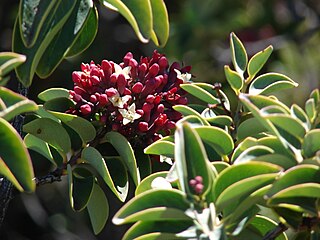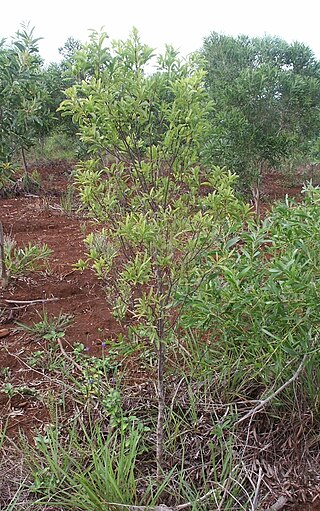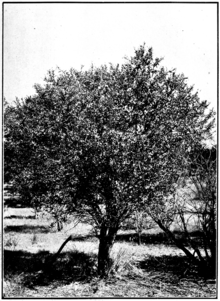
Sandalwood is a class of woods from trees in the genus Santalum. The woods are heavy, yellow, and fine-grained, and, unlike many other aromatic woods, they retain their fragrance for decades. Sandalwood oil is extracted from the woods. Sandalwood is often cited as one of the most expensive woods in the world. Both the wood and the oil produce a distinctive fragrance that has been highly valued for centuries. Consequently, some species of these slow-growing trees have suffered over-harvesting in the past.

Acacia aneura, commonly known as mulga or true mulga, is a shrub or small tree native to arid outback areas of Australia. It is the dominant tree in the habitat to which it gives its name (mulga) that occurs across much of inland Australia. Specific regions have been designated the Western Australian mulga shrublands in Western Australia and Mulga Lands in Queensland.

Santalum is a genus of woody flowering plants in the Santalaceae family, the best known and commercially valuable of which is the Indian sandalwood tree, S. album. Members of the genus are trees or shrubs. Most are root parasites which photosynthesize their own food, but tap the roots of other species for water and inorganic nutrients. Several species, most notably S. album, produce highly aromatic wood, used for scents and perfumes and for herbal medicine. About 25 known species range across the Indomalayan, Australasian, and Oceanian realms, from India through Malesia to the Pacific Islands, as far as Hawaiʻi and the Juan Fernández Islands off the coast of South America.

Santalum acuminatum, the desert quandong, is a hemiparasitic plant in the sandalwood family, Santalaceae, which is widely dispersed throughout the central deserts and southern areas of Australia. The species, especially its edible fruit, is also commonly referred to as quandong or native peach. The use of the fruit as an exotic flavouring, one of the best known bush tucker, has led to the attempted domestication of the species.

The townsite of Tambellup is located in the Great Southern region of Western Australia, 317 km south-east of Perth on the Great Southern Highway where it crosses the Gordon River. It is 23 km south of Broomehill.

Acacia saligna, commonly known by various names including coojong, golden wreath wattle, orange wattle, blue-leafed wattle, Western Australian golden wattle, and, in Africa, Port Jackson willow, is a small tree in the family Fabaceae. Native to Australia, it is widely distributed throughout the south west corner of Western Australia, extending north as far as the Murchison River, and east to Israelite Bay. The Noongar peoples know the tree as Cujong.

Acacia acuminata, known as mangart and jam, is a tree in the family Fabaceae. Endemic to Western Australia, it occurs throughout the south west of the State. It is common in the Wheatbelt, and also extends into the semi-arid interior.

Eucalyptus gomphocephala, known as tuart, is a species of tree, one of the six forest giants of Southwest Australia. Tuart forest was common on the Swan coastal plain, until the valuable trees were felled for export and displaced by the urban development around Perth, Western Australia. The wood is dense, hard, water resistant and resists splintering, and found many uses when it was available. Remnants of tuart forest occur in state reserves and parks, the tree has occasionally been introduced to other regions of Australia and overseas. Remaining trees are vulnerable to phytophthora dieback, an often fatal disorder, including a previously unknown species discovered during analysis of dead specimens.

Santalum album, or Indian sandalwood, is a small tropical tree, and the traditional source of sandalwood oil. It is native to southern India and Southeast Asia. It is considered sacred in some religions like Hinduism, and some cultures place great significance on its fragrant qualities. However, the high value of the species has caused over-exploitation, to the point where the wild population is vulnerable to extinction. Indian sandalwood still commands high prices for its essential oil owing to its high alpha santalol content, but due to lack of sizable trees it is no longer used for fine woodworking as before. The plant is long-lived, but harvest is only viable after many years.

Hampton is an interim Australian bioregion located in southeastern coastal Western Australia, with a small portion (4%) extending into adjacent South Australia. It has an area of 1,088,198 hectares. The Hampton bioregion is part of the Coolgardie woodlands ecoregion.

Santalum haleakalae, known as Haleakala sandalwood or ʻIliahi in Hawaiian, is a species of flowering tree in the sandalwood family, that is endemic to the islands of Maui, Lanai, and Molokai in the Hawaiian Islands, part of the United States. It grows in subalpine shrublands at elevations of 1,900 to 2,700 m, especially on the slopes of Haleakalā.

Santalum lanceolatum is an Australian tree of the family Santalaceae. It is commonly known as desert quandong, northern sandalwood, sandalwood, or true sandalwood and in some areas as burdardu. The mature height of this plant is variable, from 1 to 7 m. The flowers are green, white, and cream, appearing between January and October. The species has a distribution throughout central Australia, becoming scattered or unusual in more southern regions.

Santalum murrayanum, commonly known as the bitter quandong, is an Australian plant in the sandalwood family, Santalaceae. The Noongar name for the plant is coolyar.

The flora of Australia comprises a vast assemblage of plant species estimated to over 21,000 vascular and 14,000 non-vascular plants, 250,000 species of fungi and over 3,000 lichens. The flora has strong affinities with the flora of Gondwana, and below the family level has a highly endemic angiosperm flora whose diversity was shaped by the effects of continental drift and climate change since the Cretaceous. Prominent features of the Australian flora are adaptations to aridity and fire which include scleromorphy and serotiny. These adaptations are common in species from the large and well-known families Proteaceae (Banksia), Myrtaceae, and Fabaceae.
Sandalwood is the common name of many species of plants and their wood and oils.

Sandalwood oil is an essential oil obtained from the steam distillation of chips and billets cut from the heartwood of various species of sandalwood trees, mainly Santalum album and Santalum spicatum.

Santalum freycinetianum, the forest sandalwood, Freycinet sandalwood, or ʻIliahi, is a species of flowering tree in the European mistletoe family, Santalaceae, that is endemic to the Hawaiian Islands. Its binomial name commemorates Henri Louis Claude de Saulces de Freycinet, a 19th-century French explorer. ʻIliahi inhabits dry, coastal mesic, mixed mesic, and wet forests on Oʻahu, Kauaʻi, Lānaʻi, Maui, and Molokaʻi at elevations of 250–950 m (820–3,120 ft). It grows in areas that receive 500–3,800 mm (20–150 in) of annual rainfall. Like other members of its genus, ʻiliahi is a root hemi-parasite, deriving some of its nutrients from the host plant; common hosts include koa, koaiʻa, and ʻaʻaliʻi.

Santalum ellipticum, commonly known as ʻIliahialoʻe (Hawaiian) or coastal sandalwood, is a species of flowering plant in the mistletoe family, Santalaceae, that is endemic to the Hawaiian Islands. It is a sprawling shrub to small tree, typically reaching a height of 1–5 m (3.3–16.4 ft) and a canopy spread of 1–3 m (3.3–9.8 ft), but is extremely variable in size and shape. Like other members of the genus, S. ellipticum is a hemi-parasite, deriving some of its nutrients from the host plant by attaching to its roots.

Santalum austrocaledonicum, or New Caledonia sandalwood, is a sandalwood tree from the family Santalaceae. It is a small tree with gray bark and green leaves, and is parasitic. Most have been removed from their habitat due to logging; very few trees remain in the wild.
Ximenynic acid is trans-11-octadecen-9-ynoic acid, a long-chain acetylenic fatty acid.





















